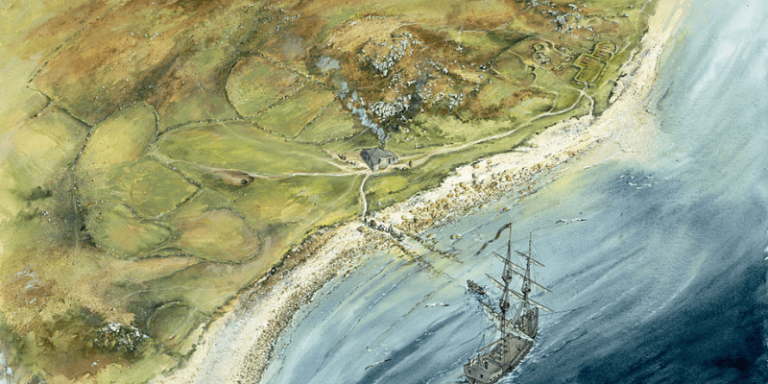Quarantine: It Worked Against Plague
Black Death was devastating the first time around, but people quickly learned how to respond.
By: Mark Angelides | May 16, 2020 | 526 Words

St Helen’s Quarantine Station, Isles of Scilly, c1764. Artist Peter Dunn. (Photo by English Heritage/Heritage Images/Getty Images)
If we look at the history of pandemics and fighting diseases, there may be one or two lessons we can learn. Some of the responses to threats like the Black Death just didn’t work, but they may be just the thing to apply right now.
When we think of the Black Death, we often associate it with a pestilence that swept Europe from around 1347 and went on to kill a third of all Europeans. But the roots go back much earlier. In fact, already by 1340, people had heard of a terrible plague ravaging such far-flung places as China, Egypt, and Syria. It was in October of 1347 that it first arrived on European shores aboard a dozen ships docking at Messina in Sicily.
The people of the day knew that there was a deadly plague in foreign lands, but they didn’t understand that such a thing could be transmitted. It’s estimated that China, with its enormous population, lost 50% of all its people.
Centuries earlier, the father of medicine, Hippocrates, had written on the subject of plagues spreading and what one should do about them. He wrote: “Cito, Longe, Tarde,” which translates to “Leave quickly, go far away and come back slowly.” Wise words, indeed.
In 1348, authorities in Venice decided to take action and began stopping ships coming in from ports where they suspected the plague existed. They closed the city waters, and all crafts that came in were subject to a 40-day isolation period … this is actually where we get the word “quarantine” from, the Italian for 40, “quaranta.” But it was already far too late. The disease was in, and the toll was devastating to the region.
However, across much of Europe, these lessons were learned. In some places where they imposed harsh measures, isolation, and limiting travel, the disease passed quickly; others were not so lucky.
The disease ran its course, leaving a third of all Europeans dead, but the survivors were perhaps a little wiser.
More than 200 years later, in 1665, the plague came back in force in London. Forewarned is forearmed, and King Charles the Second and his government swiftly left the city, leaving orders that those who were sick were to be quarantined, bodies were to be burned, and all public gatherings to be shut down. Cities across the nation closed down access, blocked all trade, and waited.
Several other cities were infected, some to a devastating degree, but despite London losing 15% of its population (almost 100,000 people), the cold weather came and with it the end of the spread. If they had not taken the actions of shutting down whole cities, and in Scotland’s case, an entire border, who knows how far the disease would have gone.
The main lesson we can take away from this is that when you need to act, act fast and act effectively. As far as we know right now, COVID-19 is not as deadly as the plague. Yes, some have died, and likely many more will be infected before it runs its course, but it’s no Black Death. We don’t need to panic – but we do need to take heed of history.
















